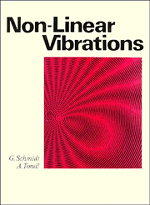Book contents
- Frontmatter
- Preface
- Contents
- Introduction
- 1 Basic properties and definitions
- 2 Methods of solution
- 3 Auxiliary curves for analysis of non-linear systems
- 4 Analysis in the phase plane
- 5 Forced, parametric and self-excited vibrations
- 6 Vibrations of systems with many degrees of freedom
- 7 Investigation of stability in the large
- 8 Analysis of some excited systems
- 9 Quenching of self-excited vibration
- 10 Vibration systems with narrow-band random excitation
- 11 Vibration systems with broad-band random excitation
- 12 Systems with autoparametric coupling
- Appendix
- Bibliography
- Index
9 - Quenching of self-excited vibration
Published online by Cambridge University Press: 10 May 2010
- Frontmatter
- Preface
- Contents
- Introduction
- 1 Basic properties and definitions
- 2 Methods of solution
- 3 Auxiliary curves for analysis of non-linear systems
- 4 Analysis in the phase plane
- 5 Forced, parametric and self-excited vibrations
- 6 Vibrations of systems with many degrees of freedom
- 7 Investigation of stability in the large
- 8 Analysis of some excited systems
- 9 Quenching of self-excited vibration
- 10 Vibration systems with narrow-band random excitation
- 11 Vibration systems with broad-band random excitation
- 12 Systems with autoparametric coupling
- Appendix
- Bibliography
- Index
Summary
Basic considerations and methods of solution
Since self-excited vibration impairs reliable operation and endangers the safety of miscellaneous machinery and structures, its suppression constitutes one of the major tasks of vibration engineering. An ideal and very expedient means to this end is the removal of the source of self-excitation. However, this so-called active method is not applicable in all cases. The systems in which it fails include those where self-excitation is an inherent characteristic of the technological process (for example, the cutting forces in machine tools) or is inherent in the function of the device (for example, the hydrodynamic forces in journal bearings). Sometimes, as in the case of self-excited oscillations – galloping – of high-voltage transmission lines, application of the active method is not feasible because of economic or operational reasons. In cases of these sorts resort must be made to passive methods, that is, to paralyzing the destabilizing effect of negative damping, which is obtained in the equations of motion when expressing the action of forces producing self-excitation, by an increase in the level of positive damping. This chapter deals exclusively with the passive methods of quenching selfexcited vibration.
The practicability and efficacy of the various means used in connection with these methods will be examined using systems which belong to the class represented in its simplest form by the van der Pol oscillator. Only systems with a finite number of degrees of freedom will be considered.
- Type
- Chapter
- Information
- Non-linear Vibrations , pp. 278 - 322Publisher: Cambridge University PressPrint publication year: 1986



